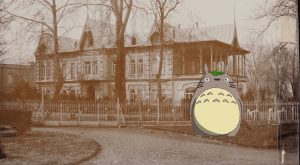Without Museum Objects
The Silk Museum started to spin a cocoon around itself. After the building’s rehabilitation, the museum will reopen in a new form. The objects are being temporarily wrapped and boxed. The vitrines that were designed specifically for this space stand empty. The traces of frames can be noticed on the walls.
“Without Museum Objects” is a series of events that invite you to an unusual environment for the museum. Its permanent exhibition cannot be seen during the transitional stage of rehabilitation. This moment is a unique opportunity to concentrate on the exhibition space itself and think about the Silk Museum’s specificity through different works and approaches. Imagining the musealia, feeling the space without objects, or partially filling in the empty spaces also show the significance of observing exhibitions and items in the real world.

Leafeaters
22.06. – 01.07.2021
The domestic silkworm (Lat. Bombyx mori) mostly feeds on mulberry leaves so that it can grow and spin a cocoon around itself. Afterward, humans reel the thread, process it, and create textiles. Therefore, an important part of the museum’s collection includes objects concerning mulberry trees (Lat. Morus) – herbarium of different species and hybrids, tree diseases, ethnographic or laboratory photographs, scientific achievements, etc.
The first exhibition in the framework of “Without Museum Objects” takes place in the “Mulberry Room” and concerns the relationship between humans, nature, and silk. Inspired by the museum, Nino Eliashvili used watercolor layers in her paintings (2021). Resembling the transparency of silk, these surfaces connect various objects and faceless bodies. Furthermore, the site-specific display highlights the former exhibition, or more specifically its traces in the room. Artist’s books by Nino Zirakashvili also deal with the topics of exposition. “Entomological Collection” (2018) was inspired by one of the drawers in the museum’s butterfly collection. Labels gathered in this display box make us think about those museum objects that have not survived. In the artist’s book “Herbarium” (2020), she combined industrial textile samples with floral motifs by using minimal information about them. While the silk industry stopped functioning in Georgia towards the end of the 20th century, only fragmentary information remains about these textiles or their authors.
Curated by Data Chigholashvili

Exposition photos by Medea Sharikadze.












